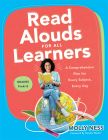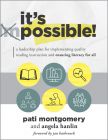
Who Says I Can’t?
A Four-Year Plan to Erase the Reading Gap and Achieve Proficiency by Fourth Grade
Discover evidence-based, effective reading strategies to close the reading gap, understand the science of reading, and learn practical techniques for improving reading comprehension, phonics, vocabulary, and critical thinking.
Experience the convenience of eBooks! Access your eBooks anytime, anywhere on any desktop, Android, or iOS device through VitalSource. eBook purchases are limited to one eBook per title, per account. Please visit our FAQ for more information.
Eliminate the reading gap for marginalized children
Eliminating the reading achievement gap is essential for long-term school success. In Who Says I Can’t?, the authors explain how to close the third-grade reading gap for marginalized students. They supply educators with research, strategies, structure, and support necessary to revise current practices so that all children, regardless of ethnic, racial, or socioeconomic deterrents, will read for meaning before grade 4.
K–4 educators can use this book to:
- Learn current research on the third-grade reading gap and why it matters
- Understand the importance of teaching phonics and phonemics in the early grades
- Explore how to expand vocabulary for students below target levels
- Guide students on forming meaning in cognitive and metacognitive ways
- Provide reading material with diverse characters to encourage investment and belonging
Related Topics
Additional Information
“I think that the publication of this book could fill a necessary gap for schools in low-income areas that serve primarily children of colour, although I think that the strategies outlined could work for most children.”
“As you dive into the reading and the content, it becomes clear that this is heavily researched methodology. This research combined with the ability to say that it works by referencing a school that has implemented this process creates a strong case for using this in a person’s classroom.”
When can I access my eBook? Your eBook will be accessible through VitalSource once your payment has been processed.*
*When using a check or purchase order, the order submitted online will not be processed until Solution Tree receives the check or a copy of the signed official purchase order. Your purchase order must note payment terms of net 30 days. We cannot process purchase orders that do not note these payment terms. Please submit all payments to [email protected].
How do I access my eBook?
To access your eBook:
- Create a free VitalSource account by visiting VitalSource.com. If you already have a VitalSource account, please log in to your account.
- Paste the redemption code that Solution Tree will email you in the “Redemption Code” field on VitalSource.com/Redeem. (Note: You can also access your redemption code within your Solution Tree account under the “eBook” section.)
- Click “Redeem.”
- Enjoy! Once your code is redeemed, your book will be added to your VitalSource Bookshelf and can be read anytime, anywhere.
What are the technical requirements for accessing the eBook? A VitalSource account is required. To sign up for your free account, please visit VitalSource.com.
What if I have trouble accessing my eBook? Please contact VitalSource by emailing [email protected] or by utilizing their Live Chat feature.
What are the shipping and handling costs? There are no shipping or handling costs associated with eBooks. For paperback and hardcover book purchases, standard shipping costs apply. Please visit the Product Orders page for more information on shipping and handling costs.
Can I purchase multiple copies of the same eBook? Bulk orders are not currently available through the website. Website purchases are limited to one eBook per title, per account. If you want to order multiple copies of an eBook, please contact customer support at [email protected].
What if I need to request a refund on my eBook order? RETURN POLICY: We are unable to accept returns or cancel previously placed eBook orders.



